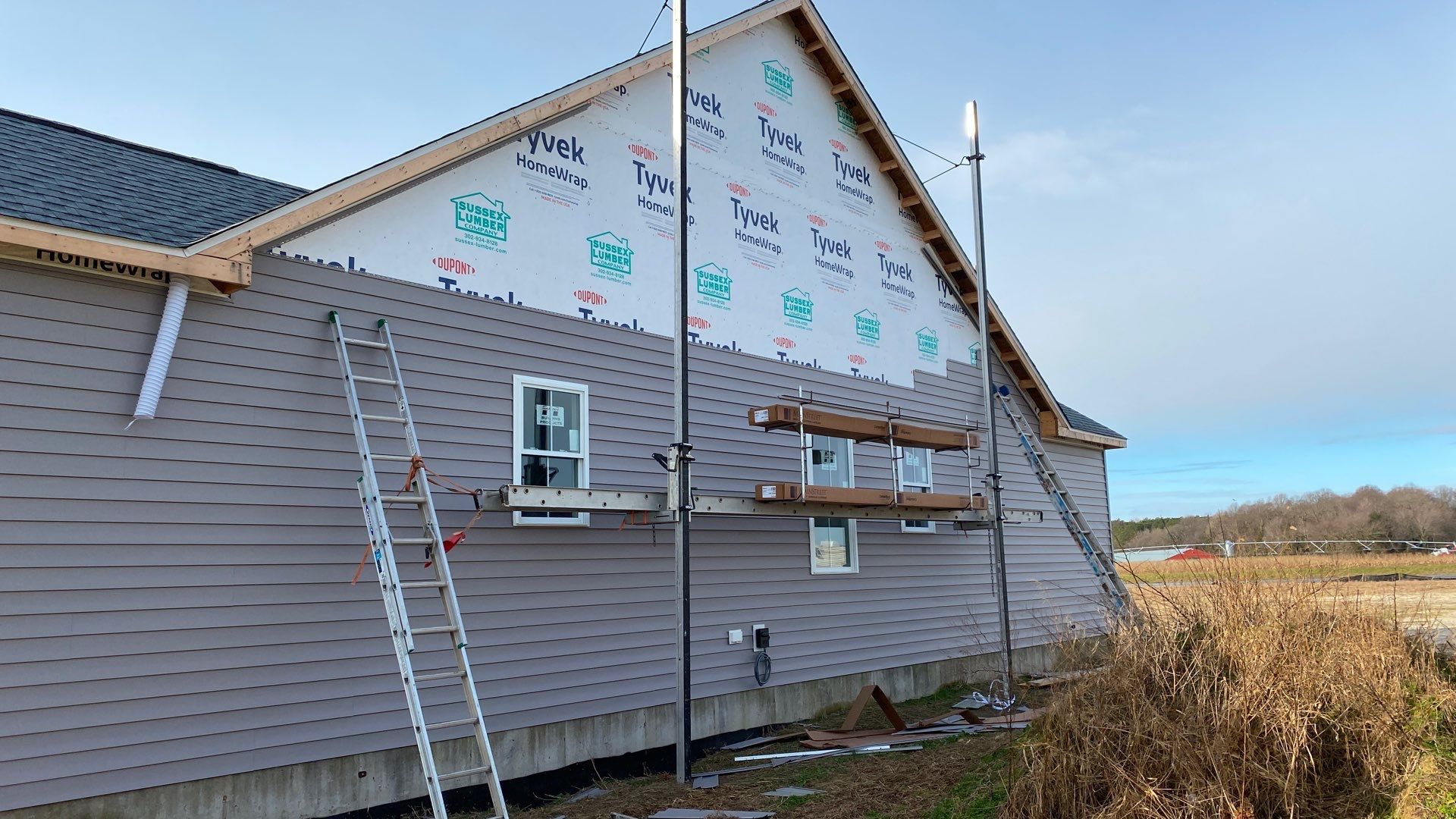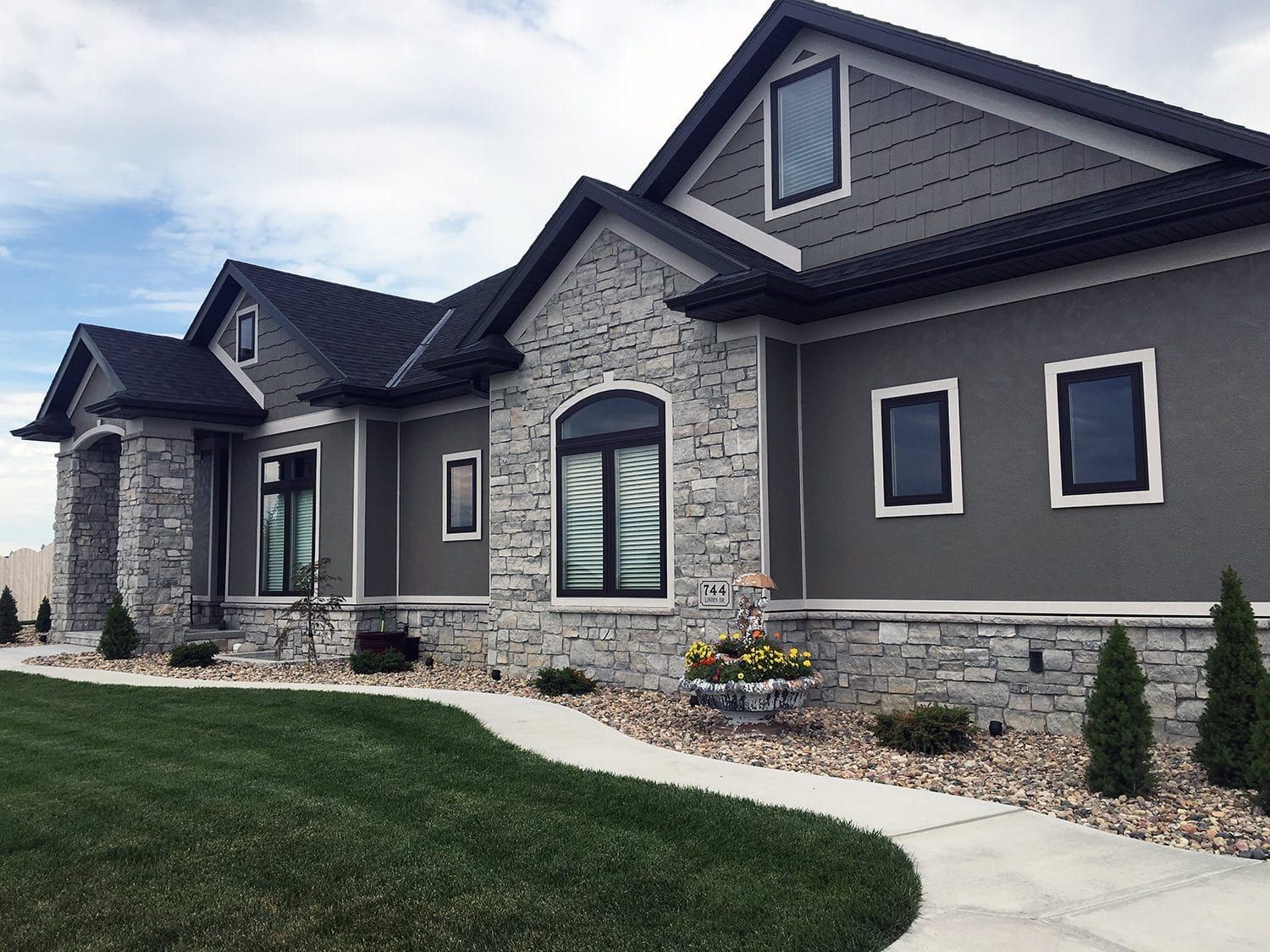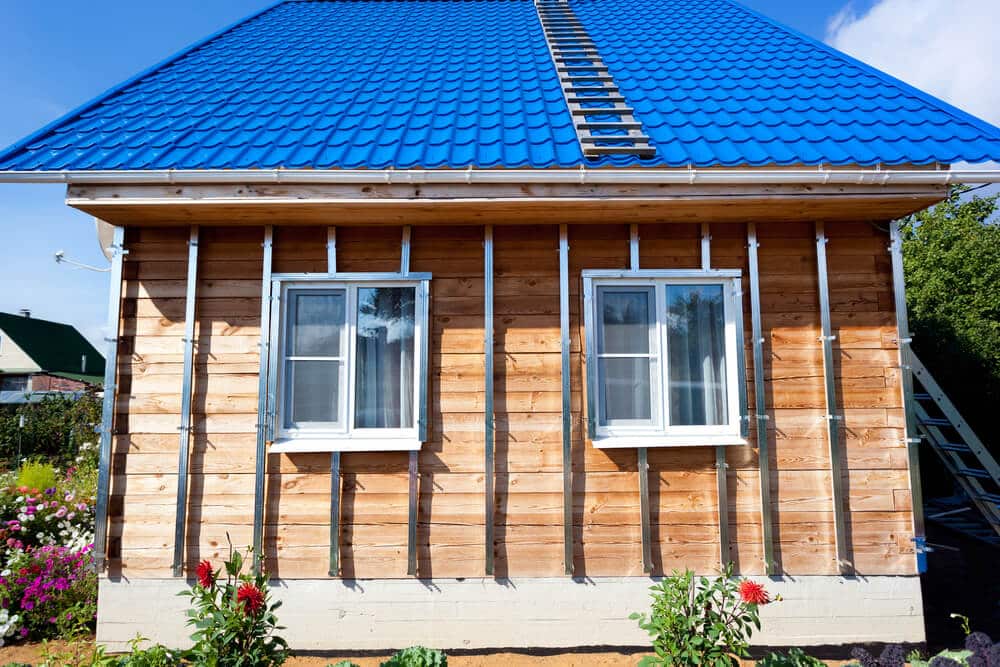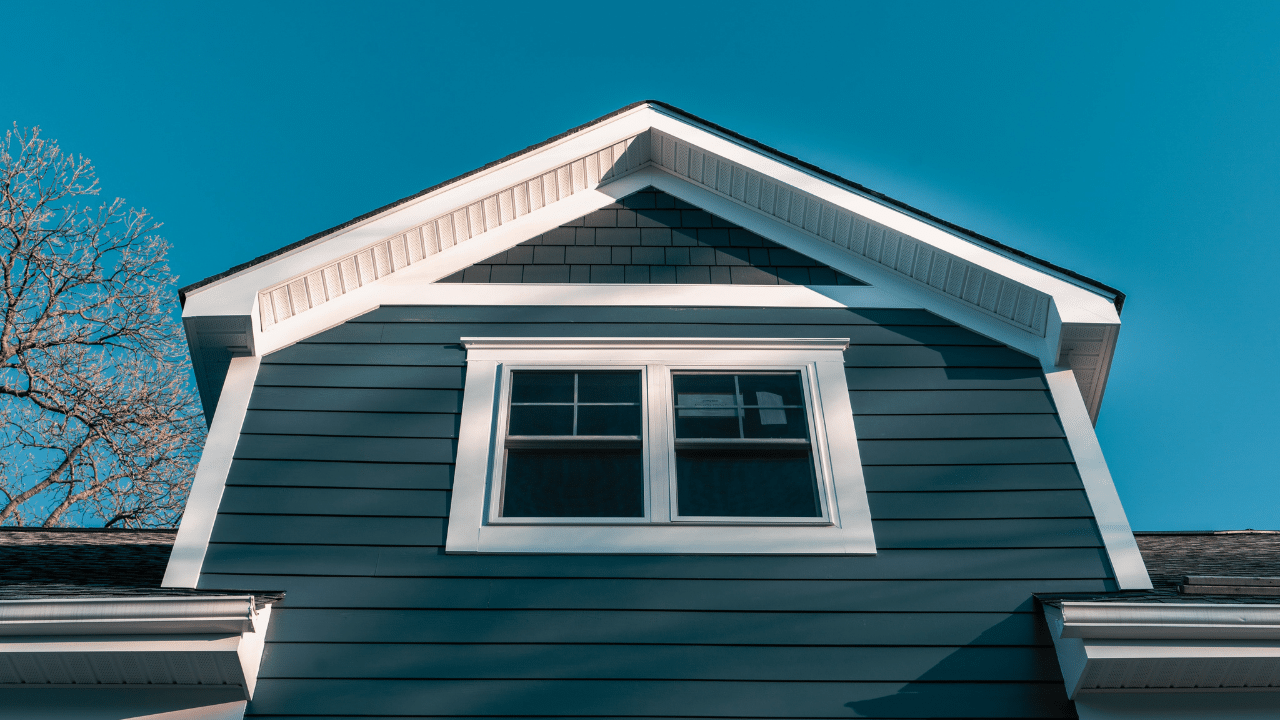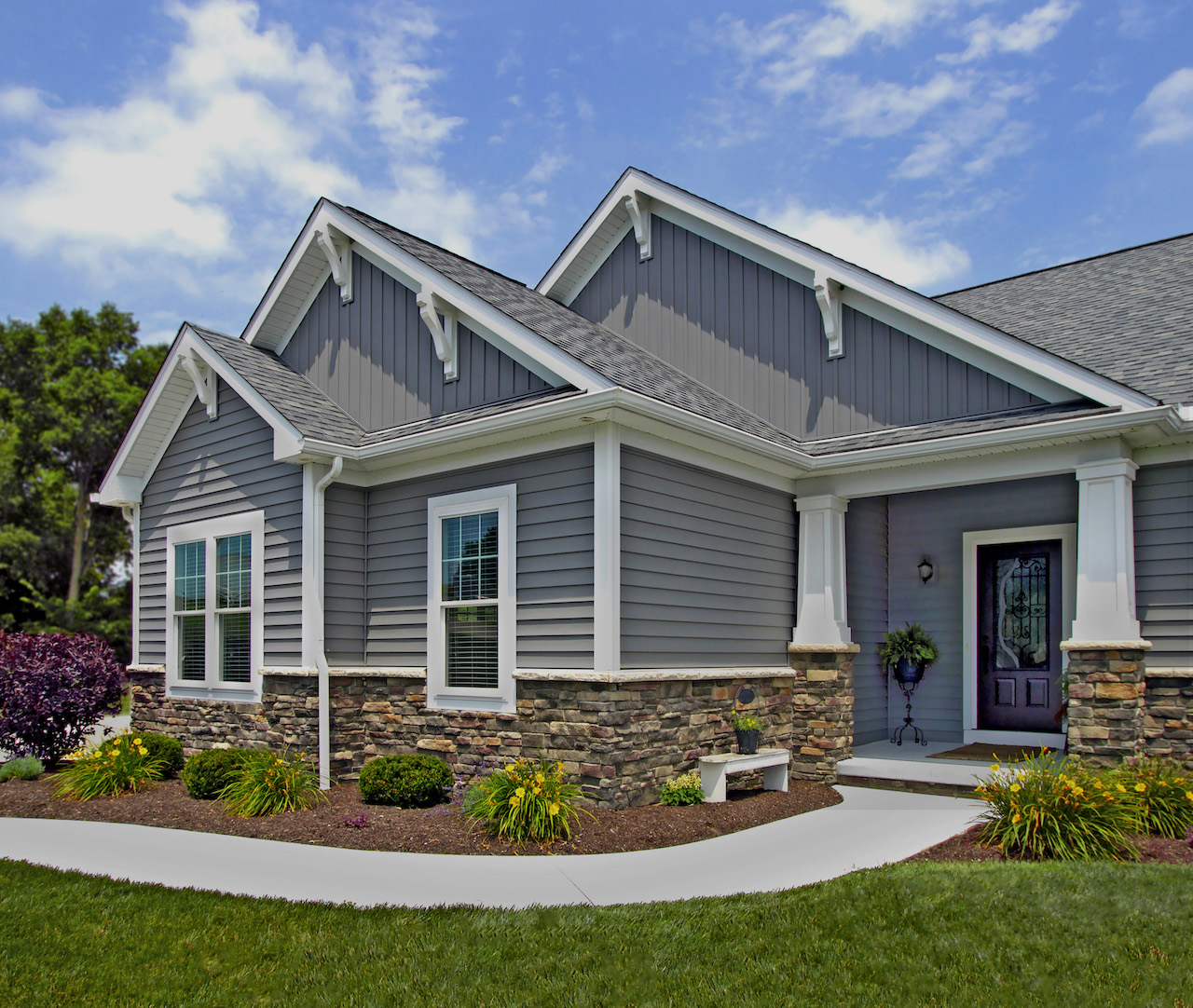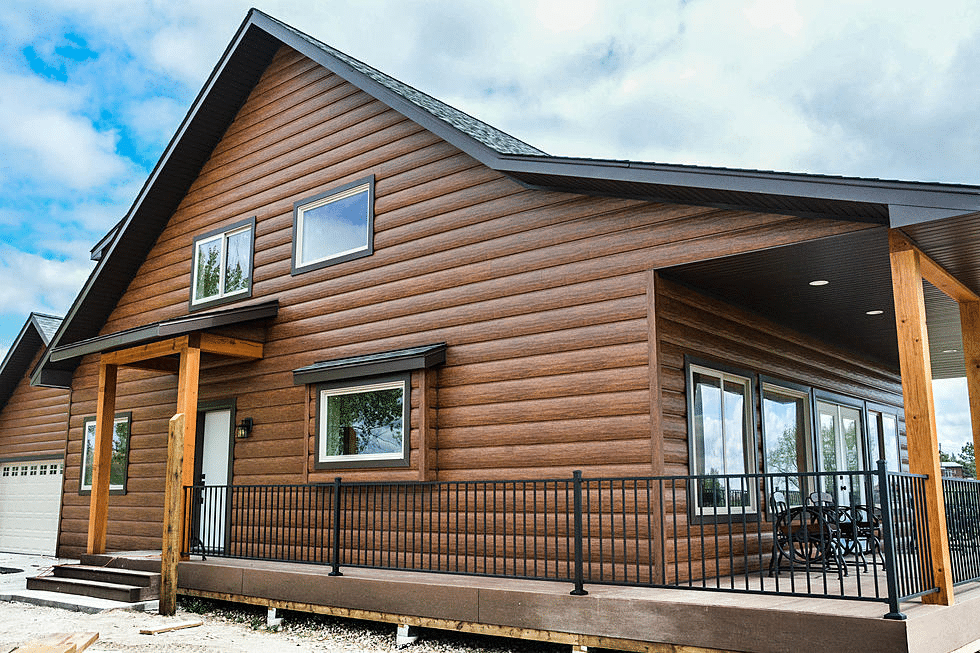Energy-efficient Insulated Siding: A Home Upgrade
Energy-efficient insulated siding is revolutionizing home improvement. It offers a compelling blend of enhanced energy efficiency, cost savings, and aesthetic appeal, surpassing traditional siding in numerous ways. This guide delves into the benefits, installation, maintenance, and environmental considerations of this innovative exterior cladding, helping homeowners make informed decisions for a more comfortable and sustainable home.
From the various materials available, like vinyl, fiber cement, and foam, to the significant reduction in energy bills and improved home comfort, we’ll explore all aspects of energy-efficient insulated siding. We’ll also cover the long-term cost benefits, including potential government incentives, and address common concerns regarding installation, maintenance, and environmental impact.
Introduction to Energy-Efficient Insulated Siding
Upgrading your home’s exterior with energy-efficient insulated siding offers significant advantages over traditional siding options. It not only enhances your home’s curb appeal but also provides substantial long-term savings on energy bills and contributes to a more environmentally friendly lifestyle. The key difference lies in the integrated insulation layer, which creates a more effective barrier against heat transfer, keeping your home warmer in winter and cooler in summer.
Energy-efficient insulated siding significantly reduces heat transfer through your home’s exterior walls. This improved insulation translates to lower heating and cooling costs, potentially saving homeowners hundreds of dollars annually depending on climate, home size, and existing insulation levels. For example, a homeowner in a colder climate might see a 15-20% reduction in heating costs, while a homeowner in a hotter climate could experience a similar decrease in cooling costs. This reduction in energy consumption also contributes to a smaller carbon footprint, aligning with environmentally conscious building practices.
Insulated Siding Materials
Several materials are used in the manufacturing of energy-efficient insulated siding, each offering a unique set of properties and benefits. The choice of material often depends on factors such as budget, aesthetic preferences, and desired performance characteristics.
- Vinyl Insulated Siding: Vinyl siding is a popular choice due to its affordability, low maintenance, and wide range of colors and styles. The insulation is typically a foam core bonded to the vinyl exterior. This combination provides good insulation value and durability. Vinyl is relatively lightweight, making installation easier and less labor-intensive.
- Fiber Cement Insulated Siding: Fiber cement siding is known for its exceptional durability and fire resistance. It’s a more expensive option than vinyl but offers superior longevity and weather protection. The insulation core can vary, but often includes foam or other insulating materials. Fiber cement is heavier than vinyl, requiring more robust installation techniques.
- Foam Insulated Siding: Foam insulated siding, often made from polyurethane or polyisocyanurate, offers excellent insulation properties. It’s lightweight and can be installed directly over existing siding in some cases, making it a suitable option for renovations. However, it may require additional finishing materials for a complete aesthetic look, and it can be more susceptible to damage from impact.
Insulated Siding Installation Process
The installation process for energy-efficient insulated siding typically involves several key steps. While the specifics may vary slightly depending on the chosen material and existing house structure, the overall process remains consistent. Proper installation is crucial to ensure optimal energy efficiency and longevity of the siding.
- Preparation: This initial stage involves assessing the existing siding, removing any damaged or deteriorated sections, and preparing the underlying wall surface. This might include repairs to sheathing or caulking.
- Installation of Furring Strips (if necessary): Depending on the substrate and the type of siding, furring strips might be needed to create a level surface and provide adequate spacing for ventilation.
- Siding Panel Installation: The insulated siding panels are then installed, typically starting from the bottom and working upwards. Each panel is carefully aligned and secured using appropriate fasteners. Overlapping panels ensures weather tightness.
- Finishing and Trim: Once the siding panels are installed, finishing touches are added, including trim pieces, corner boards, and window and door casings. This ensures a clean, professional finish.
Energy Efficiency and Cost Savings
Investing in energy-efficient insulated siding offers significant long-term benefits beyond improved aesthetics. The primary advantage lies in substantial reductions in energy bills, leading to considerable cost savings over the lifespan of your home. This translates to a lower carbon footprint and a more comfortable living environment.
Energy-efficient insulated siding acts as a barrier against heat loss in winter and heat gain in summer, reducing the strain on your heating and cooling systems. This improved insulation minimizes the energy required to maintain a comfortable indoor temperature, directly impacting your monthly utility expenses.
Energy Savings Comparison
The following table illustrates a hypothetical comparison of energy bills before and after installing energy-efficient insulated siding. These figures are estimates and can vary depending on factors such as climate, home size, and existing insulation levels. Actual savings will vary.
| Material | Initial Cost | Estimated Annual Energy Savings | Return on Investment (ROI) |
|---|---|---|---|
| Standard Vinyl Siding | $8,000 | $150 | 53 years |
| Energy-Efficient Insulated Vinyl Siding | $12,000 | $500 | 24 years |
The table shows that while the initial investment in energy-efficient siding is higher, the annual energy savings are significantly greater, resulting in a faster return on investment.
Long-Term Cost Savings
Reduced energy consumption translates to substantial long-term cost savings. Over the course of 10 years, for example, the savings from energy-efficient insulated siding could reach $5,000 (based on the $500 annual savings shown in the table above). This cumulative savings significantly offsets the higher initial cost of the material. Consider the accumulated savings over the typical 20-30 year lifespan of the siding.
Government Rebates and Tax Incentives
Many governments offer rebates or tax incentives to encourage homeowners to make energy-efficient improvements to their homes. These incentives can significantly reduce the upfront cost of installing energy-efficient insulated siding. For example, some programs offer a percentage discount on the purchase and installation of qualifying materials, while others provide direct tax credits. Contact your local utility company or energy efficiency agency to determine what programs are available in your area. Eligibility criteria and incentive amounts vary by location and program.
Impact on Home Comfort and Indoor Climate
Insulated siding significantly enhances your home’s comfort by creating a more stable and pleasant indoor environment. Its impact extends beyond just energy savings; it directly affects temperature consistency, reduces drafts, and even minimizes noise pollution. This leads to a more comfortable and enjoyable living space.
Insulated siding improves home insulation by acting as an additional barrier against heat transfer. This means less heat escapes in winter and less heat enters in summer. The insulating layer within the siding reduces drafts by preventing air infiltration through the exterior walls. This is particularly noticeable around windows and doors, common areas for air leaks. This improved air sealing contributes to a more consistent and comfortable indoor temperature throughout the year, regardless of outside weather conditions.
Consistent Indoor Temperature Maintenance
The added insulation provided by insulated siding helps maintain a consistent indoor temperature by minimizing temperature fluctuations caused by external weather changes. For example, during a cold snap, a home with insulated siding will experience less temperature drop than a home without it. Similarly, during heat waves, the interior will stay significantly cooler. This translates to less reliance on heating and cooling systems, resulting in increased comfort and energy savings. A well-insulated home maintains a more stable temperature, leading to a more comfortable and even living environment. Imagine a home where you don’t feel a significant temperature difference between rooms or near exterior walls – that’s the benefit of effective insulation.
Noise Reduction
Insulated siding also offers a surprising benefit: noise reduction. The dense material of the siding and the air pockets within the insulation act as a sound buffer, reducing the amount of outside noise that penetrates the home. This is particularly beneficial for homes located near busy streets, airports, or other noisy environments. The reduction in noise pollution creates a more peaceful and relaxing atmosphere within the home. For instance, the constant hum of traffic might be significantly dampened, creating a quieter and more serene living space. This improvement in sound insulation contributes significantly to overall home comfort and peace of mind.
Material Properties and Durability
Choosing insulated siding involves understanding the material properties and how they affect the siding’s longevity and maintenance needs. Different materials offer varying levels of durability, resistance to damage, and lifespan, influencing both the initial cost and long-term expenses.
Different insulated siding materials exhibit unique properties impacting their durability and lifespan. Factors such as impact resistance, weatherability, and susceptibility to fading or warping significantly influence a siding’s longevity and the required maintenance.
Insulated Vinyl Siding Durability and Maintenance
Vinyl insulated siding is known for its relatively low maintenance requirements. Its durability stems from its resistance to rot, insect infestation, and moisture damage. Regular cleaning with soap and water is usually sufficient to maintain its appearance. However, extreme weather conditions, such as hailstorms, can cause damage, requiring repairs or replacements. While generally durable, prolonged exposure to intense UV radiation can lead to fading or discoloration over many years. The lifespan of vinyl siding typically ranges from 20 to 40 years, depending on the quality of the product and the climate.
Insulated Fiber Cement Siding Durability and Maintenance
Fiber cement siding offers superior durability compared to vinyl. Its composition, a mixture of cement, cellulose fibers, and other additives, provides high resistance to impact, fire, and moisture. This makes it a long-lasting option, with a typical lifespan exceeding 50 years. Maintenance involves periodic cleaning to remove dirt and debris. While resistant to most damage, fiber cement can be susceptible to cracking under extreme stress, and it can require repainting every 10-15 years to maintain its appearance and protect against UV damage.
Insulated Polyurethane Foam Siding Durability and Maintenance
Insulated siding incorporating polyurethane foam offers excellent thermal performance. However, the exposed outer layer of the siding, which is often vinyl or aluminum, determines its durability and maintenance needs. The foam core itself is highly resistant to moisture and insects, contributing to the overall lifespan of the system. Maintenance requirements are similar to vinyl or aluminum siding, depending on the outer layer material. The lifespan is comparable to vinyl siding, but the thermal benefits may offset the need for frequent replacements. Potential issues might arise if the outer layer is damaged, exposing the foam core to moisture.
Potential Issues and Drawbacks of Insulated Siding Materials
Certain challenges are associated with each type of insulated siding. For instance, vinyl siding can warp or crack under extreme temperature fluctuations. Fiber cement, while durable, is more prone to cracking than vinyl and is heavier, requiring more robust installation techniques. Polyurethane foam-based systems require careful installation to avoid moisture intrusion, which can degrade the foam’s insulating properties. Furthermore, the initial cost of some insulated siding options, like fiber cement, can be higher than traditional siding materials. The long-term cost savings from reduced energy consumption, however, often outweigh the higher upfront investment.
Environmental Considerations
Choosing insulated siding involves more than just energy efficiency and curb appeal; it has significant environmental implications throughout its lifecycle. From manufacturing to disposal, the materials used and their production processes contribute to the overall environmental impact of your home. Understanding these impacts is crucial for making informed and sustainable choices.
The environmental impact of insulated siding stems primarily from the extraction and processing of raw materials, manufacturing processes, transportation, and ultimately, disposal or recycling at the end of its lifespan. Different materials have vastly different environmental footprints, influencing factors such as energy consumption, greenhouse gas emissions, and waste generation.
Manufacturing and Disposal of Insulated Siding Materials
The environmental impact varies greatly depending on the siding material. Fiber cement siding, for example, requires significant energy during manufacturing due to the high temperatures needed for cement curing. Its disposal often involves landfill space, though some components can be recycled. Vinyl siding, while often recyclable, requires substantial energy during its plastic production phase and releases greenhouse gases. Wood siding, a more renewable resource, still requires processing and transportation, contributing to its carbon footprint, especially if sourced from unsustainable forestry practices. Finally, metal sidings, such as aluminum or steel, have relatively high embodied energy due to the extraction and processing of metals, but they are often recyclable at the end of their lifespan.
Embodied Carbon Comparison: Insulated vs. Traditional Siding
Embodied carbon refers to the greenhouse gas emissions associated with a product’s entire lifecycle, from raw material extraction to manufacturing, transportation, and disposal. Insulated siding, while generally offering long-term energy savings, does have an embodied carbon footprint. A comparative analysis against traditional siding, such as wood or vinyl, needs to consider the thickness and insulation properties. Thicker insulation may result in higher embodied carbon initially, but the subsequent energy savings throughout the siding’s lifespan can significantly offset this. For instance, a study comparing a high-performance insulated siding system to a standard vinyl siding system might show a higher initial embodied carbon for the insulated option, but a lower overall carbon footprint over 50 years due to reduced heating and cooling energy consumption. This net effect is dependent on factors such as climate, building design, and the specific materials used.
Insulated Siding’s Role in Reducing a Home’s Carbon Footprint
Insulated siding contributes to reducing a home’s overall carbon footprint primarily by improving energy efficiency. By minimizing heat transfer through the walls, insulated siding reduces the need for heating and cooling, thereby decreasing reliance on energy sources like fossil fuels which are major contributors to greenhouse gas emissions. This reduction in energy consumption translates directly to a smaller carbon footprint for the home. For example, a home retrofitted with high-performance insulated siding might see a 20-30% reduction in its heating and cooling energy use, significantly reducing its contribution to climate change. The long-term energy savings from improved insulation often outweigh the initial embodied carbon of the material, making it a potentially sustainable choice.
Visual Appeal and Design Options
Energy-efficient insulated siding offers a surprising array of aesthetic choices, moving beyond the purely functional to enhance your home’s exterior significantly. The days of limited color palettes and uninspired designs are over; modern insulated siding provides homeowners with a wealth of options to personalize their homes and boost curb appeal.
Insulated siding can dramatically improve a home’s visual appeal by offering a clean, modern look that is both durable and low-maintenance. The variety of colors and textures available allows homeowners to create a unique and stylish exterior that reflects their personal taste. Furthermore, the improved energy efficiency often translates to fewer visible signs of wear and tear, like fading paint, keeping your home looking its best for longer.
Color and Style Variety
Many manufacturers offer a wide range of colors and styles to complement any architectural style or personal preference. Think of the difference between a crisp, clean white siding that brightens a home, and a deep, rich brown that exudes warmth and sophistication. The subtle variations in texture—from smooth to wood-grain embossed—add another layer of design flexibility.
- Color Options: A spectrum of colors is typically available, from classic neutrals like white, beige, and gray, to bolder choices such as deep blues, greens, and reds. Many manufacturers offer custom color matching services as well.
- Texture Options: Siding can mimic the look of natural wood, stone, or stucco, offering a textured finish that adds depth and visual interest. Smooth finishes provide a clean, contemporary look, while wood-grain textures offer a more traditional feel.
- Style Options: Styles range from traditional lap siding to contemporary vertical panels, offering diverse design options to complement different architectural styles. Some manufacturers also offer specialized profiles, such as shake or shingle styles, for unique visual effects.
Enhancing Curb Appeal
Insulated siding can significantly enhance a home’s curb appeal by providing a fresh, updated look. Replacing outdated or damaged siding with energy-efficient insulated siding can instantly rejuvenate the exterior of a home, increasing its overall attractiveness and market value. The improved energy efficiency also contributes to curb appeal by reducing the need for frequent repairs or maintenance, ensuring the home maintains its attractive appearance for years to come. A consistently well-maintained home, free from peeling paint or damaged siding, is always more visually appealing.
Complementing Architectural Styles
The versatility of insulated siding allows it to seamlessly complement a wide range of architectural styles. For example, a traditional colonial home might be beautifully enhanced with clapboard-style insulated siding in a classic white or muted gray. A modern ranch-style home could benefit from sleek, vertical panels in a contemporary color like charcoal gray or deep blue. Even more ornate Victorian homes can be complemented with insulated siding that mimics the texture and details of the original materials, ensuring the home’s architectural integrity is maintained while improving energy efficiency. The key is choosing a style and color that harmonizes with the existing architectural features and landscape.
Installation and Maintenance
Proper installation and regular maintenance are crucial for maximizing the lifespan and energy-saving benefits of your insulated siding. A well-installed system will perform optimally, while neglecting maintenance can lead to premature damage and reduced efficiency. This section details the installation process and outlines essential maintenance practices.
Step-by-Step Insulated Siding Installation
Careful preparation and adherence to the manufacturer’s instructions are key to a successful installation. Skipping steps or using improper techniques can compromise the system’s integrity and its energy-saving capabilities. The following steps provide a general overview; always refer to the specific instructions provided with your chosen siding.
- Preparation: Begin by thoroughly cleaning the existing wall surface, removing any loose paint, debris, or old siding. Ensure the surface is level and dry. Address any underlying structural issues before proceeding.
- Framing and Sheathing (if necessary): If installing over existing siding that isn’t suitable for direct installation, install appropriate sheathing and framing to create a level surface. This step may involve adding furring strips to address unevenness.
- Vapor Barrier Installation: Install a continuous vapor barrier to prevent moisture from entering the wall cavity. Overlap seams and seal them carefully with appropriate tape.
- Insulated Siding Installation: Begin installing the siding panels from the bottom up, ensuring proper overlap and alignment. Use appropriate fasteners and follow the manufacturer’s recommendations for spacing and penetration depth.
- J-Channel and Trim Installation: Install J-channels and trim pieces around windows, doors, and corners. These pieces ensure a clean, finished look and protect the edges of the siding.
- Finishing Touches: Caulk any gaps or seams to prevent air infiltration. Inspect the entire installation for any issues and address them promptly.
Cleaning and Maintenance Techniques
Regular cleaning and maintenance will significantly extend the lifespan of your insulated siding and maintain its energy efficiency. The cleaning method varies depending on the siding material.
- Vinyl Siding: Vinyl siding is generally low-maintenance. Regularly wash it with a mild detergent and water solution using a soft-bristled brush or sponge. Avoid abrasive cleaners or high-pressure washers, as these can damage the surface.
- Fiber Cement Siding: Fiber cement siding is more durable and requires less frequent cleaning. Use a similar method as vinyl siding, but be mindful of any stains that may require specialized cleaners. Power washing is acceptable, but use a lower pressure setting.
- Metal Siding: Metal siding is also relatively low-maintenance. Regularly clean it with a mild detergent and water solution. For stubborn stains, use a specialized metal cleaner. Avoid abrasive materials.
Potential Installation Problems and Solutions
Several issues can arise during installation. Addressing them promptly prevents larger problems later.
| Problem | Solution |
|---|---|
| Uneven wall surface | Install furring strips to create a level surface before installing siding. |
| Improper fastener placement | Remove improperly placed fasteners and reinstall them according to manufacturer’s instructions. |
| Gaps or cracks in siding | Caulk gaps and cracks to prevent air infiltration and water damage. |
| Damage to siding during installation | Replace damaged panels immediately to maintain the integrity of the system. |
Case Studies and Real-World Examples
Seeing is believing, and when it comes to energy-efficient insulated siding, real-world examples speak volumes. The following case studies illustrate the tangible benefits homeowners have experienced after upgrading to this type of siding, showcasing improvements in energy efficiency, comfort, and overall home value.
Homeowner Testimonials: The Impact of Energy-Efficient Insulated Siding
The experiences of homeowners who have installed energy-efficient insulated siding provide compelling evidence of its effectiveness. These testimonials highlight the positive changes observed in energy bills, home comfort, and overall satisfaction. For example, Mrs. Johnson of suburban Chicago noted a significant reduction in her heating bills during the harsh winter months after installing the siding. She described the noticeable difference in indoor temperature consistency, stating that her home felt warmer and more evenly heated, eliminating drafty areas previously present near exterior walls. Mr. Garcia, a homeowner in Denver, Colorado, praised the superior insulation provided by the siding, commenting on its ability to keep his home cooler during the summer and warmer during the winter, resulting in substantial energy savings. His testimony emphasized the long-term value of the investment, noting the reduced energy consumption has translated to significant cost savings over several years.
Case Study 1: The Victorian Farmhouse
Imagine a charming Victorian farmhouse, painted a soft sage green, with intricate gingerbread trim. Before the siding upgrade, the home suffered from significant drafts and uneven temperatures. The original clapboard siding was old and weathered, offering minimal insulation. After installation of energy-efficient insulated siding, the exterior retained its original Victorian charm, but now featured a smooth, even surface. The image shows the improved aesthetic: the updated siding enhances the home’s character, with the new siding’s color complementing the existing trim. The before-and-after photos clearly show the improved appearance. Post-installation, energy consumption decreased by 30%, resulting in annual savings of approximately $700. The homeowner reported a noticeable improvement in indoor comfort, with a more consistent temperature throughout the house.
Case Study 2: The Modern Ranch
This modern ranch-style home, initially clad in plain vinyl siding, underwent a transformation with the installation of energy-efficient insulated siding. The previous siding was showing its age and offered minimal insulation. The new siding, a sleek, charcoal gray, modernized the home’s look, giving it a contemporary and clean aesthetic. The image displays the stark contrast between the dull, older siding and the fresh, modern look of the new insulated siding. The updated home looks sophisticated and updated. Energy audits revealed a 25% reduction in energy consumption after the installation, leading to an estimated annual savings of $500. The homeowner specifically noted a reduction in noise pollution from outside traffic.
Case Study 3: The Cape Cod Cottage
Picture a quaint Cape Cod cottage, originally sided with aged wood shingles. The wood was beginning to deteriorate, leading to energy loss and aesthetic concerns. The new energy-efficient insulated siding, in a classic white, maintains the home’s traditional charm while dramatically improving its energy performance. The image showcases the transformation, emphasizing how the new siding restored the cottage’s appeal while adding a layer of modern energy efficiency. The updated exterior looks fresh and inviting. The homeowner reported a 20% reduction in energy costs, amounting to approximately $400 in annual savings. The improved insulation also significantly reduced drafts and created a more comfortable living environment.
Final Wrap-Up
Upgrading your home with energy-efficient insulated siding presents a smart investment that pays off in numerous ways. From reduced energy bills and enhanced home comfort to improved curb appeal and a smaller environmental footprint, the benefits are undeniable. By carefully considering the various materials, installation processes, and long-term maintenance requirements, homeowners can enjoy the substantial advantages of this modern siding solution for years to come. It’s a decision that combines practicality, sustainability, and aesthetic enhancement for a truly upgraded living experience.



